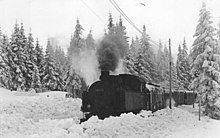Brocken Railway
| Three Annen Hohne-Brocken | |||||||||||||||||||||||||||||||||||||||||||||||||||||||||||||||||
|---|---|---|---|---|---|---|---|---|---|---|---|---|---|---|---|---|---|---|---|---|---|---|---|---|---|---|---|---|---|---|---|---|---|---|---|---|---|---|---|---|---|---|---|---|---|---|---|---|---|---|---|---|---|---|---|---|---|---|---|---|---|---|---|---|---|
|
Brocken Railway in Brocken station
| |||||||||||||||||||||||||||||||||||||||||||||||||||||||||||||||||
| Route number : | 9701 | ||||||||||||||||||||||||||||||||||||||||||||||||||||||||||||||||
| Course book section (DB) : | 325 | ||||||||||||||||||||||||||||||||||||||||||||||||||||||||||||||||
| Route length: | 19.0 km | ||||||||||||||||||||||||||||||||||||||||||||||||||||||||||||||||
| Gauge : | 1000 mm ( meter gauge ) | ||||||||||||||||||||||||||||||||||||||||||||||||||||||||||||||||
| Maximum slope : | 33 ‰ | ||||||||||||||||||||||||||||||||||||||||||||||||||||||||||||||||
| Top speed: | 40 km / h | ||||||||||||||||||||||||||||||||||||||||||||||||||||||||||||||||
|
|||||||||||||||||||||||||||||||||||||||||||||||||||||||||||||||||
The Brockenbahn is a mainly tourist- used, meter-gauge railway line of the Harzer Schmalspurbahnen (HSB). It leads from Drei Annen Hohne on the Harzquerbahn via Schierke to the Brocken .
Route
The Brockenbahn leaves the Drei Annen Hohne station ( 542 m above sea level ) next to the Harzquerbahn in a south-westerly direction. However, it crosses - still at the exit - the road to Schierke / Elend and then immediately drives into the Harz National Park , connected with an ascent of the route . Then it leads west to Schierke train station (688 m). About halfway through 1963 there was a siding to the granite quarry Knaupsholz. After leaving the Schierker train station, the route leads on a longer section through the valley of the Kalten Bode , which extends south and far below the route. The 971 m high Wurmberg appears to the left , and the train crosses Brockenstrasse for the first time .
After a tight left bend in front of the Eckerlochbrücke and another right bend, the route reaches the Goetheweg station (956 m), which is only used as a depot today. The train then leads directly to the Brocken, circling it 1½ times in a spiral , crossing Brockenstrasse again, and finally ends after 18.9 kilometers in Brocken station (1,125 m).
history

As early as 1869 there was a draft for the construction of a railway to the Brocken, but it was rejected. A new attempt by Wernigerode in 1895, however, was successful; on May 30, 1896, the building permit was granted after Prince Otto zu Stolberg-Wernigerode had assigned the corresponding land. In 1897 a Brocken Railway was planned from Bad Harzburg via Torfhaus, which had already been officially approved, but failed due to public resistance. The first section of the "Wernigeröder" Brocken Railway, from Drei-Annen-Hohne to Schierke, was opened on June 20, 1898; Served on October 15, in the winter half-year all trains ended at Schierke station . At the end of the Second World War , during the fighting in the Harz, which had been declared a fortress, major damage to the route was mainly caused by bombs and grenades. The section to the Brocken was therefore only put back into operation in 1949.
The operating company of the Brockenbahn was the Nordhausen-Wernigeroder Eisenbahn-Gesellschaft (NWE) until August 5, 1948 , after which it belonged to the Association of Publicly Owned Enterprises (VVB) of Transport, Landesbahnen Sachsen-Anhalt and from April 11, 1949 to the Deutsche Reichsbahn . Only after the German winter sports championships in 1950, which took place in Schierke, did trains run to the Brocken in winter. An Eckerloch train station was also built for the championships, but it was abandoned after the championships and was only used as a stopping point if necessary. The location of the former siding at Eckerloch train station can still be seen today.
Freight trains ran on the Brocken Railway until 1988. Up until this point in time, the trains still carried coal , oil , and building materials for the GDR border troops and soldiers from the Soviet Union up the mountain. The route had been in the restricted area since 1952 and a pass was required to enter. After the Wall was built on August 13, 1961, passenger traffic between Schierke and the Brocken ceased on August 14. In passenger traffic, the Brocken Railway from Drei Annen Hohne to Schierke remained in operation, usually only two pairs of passenger trains per day; However, a pass was also necessary here, as Schierke was also in the border area with the Federal Republic of Germany .
After reunification , the Brockenbahn was questionable at first, but the combined efforts of railway enthusiasts and politicians led by Horst Rehberger , then Minister of Economic Affairs , gave the Brockenbahn a second chance. The Bundeswehr was also involved, as the Brocken Railway was needed to transport the superfluous military equipment on the Brocken. On September 15, 1991, after the renovation, public transport on the Brocken Railway was ceremoniously reopened with two steam-powered trains. The locomotive 99 5903 , a Mallet locomotive that the NWE procured in 1897/98, and locomotive No. 99 6001 , a prototype developed by the Krupp company in 1939 , were used on the first train, and the 99 5902 on the second train and the 99 7244 , a new construction locomotive for the Deutsche Reichsbahn.
Since the privatization of the narrow-gauge railways in the Harz in 1993, the Brockenbahn has been operated by the Harzer Schmalspurbahnen (HSB).
Train operation
In winter, a maximum of six pairs of trains travel to the Brocken per day. Of these, four to and from Wernigerode by bound . In summer, traffic is compressed to eleven pairs of trains a day. The fastest train takes 49 minutes to the summit.
Picture gallery
Video
literature
- Literature by and about Brockenbahn in the catalog of the German National Library
- Jörg Bauer: 100 years of Harzquer and Brocken Railway. EK-Verlag, Freiburg 1999, ISBN 3-88255-685-4
- Manfred Bornemann: With the Brocken Railway to the Harz Mountains. Ed. Pieper, Clausthal-Zellerfeld 1985, ISBN 3-923605-23-4
- Ulrich Nitschke: The Harzquer and Brocken Railway. Transpress - VEB Publishing House for Transport, Berlin 1978
- Gerhard Zieglgänsberger, Hans Röper: The Harz narrow-gauge railways. Transpress Verlag, Stuttgart 1999, ISBN 3-613-71103-6
Web links
- Harzer Schmalspurbahnen GmbH (HSB)
- Interest group Harzer Schmalspurbahnen (IG HSB)
- Route data (from Freundeskreis Selketalbahn e.V.)











